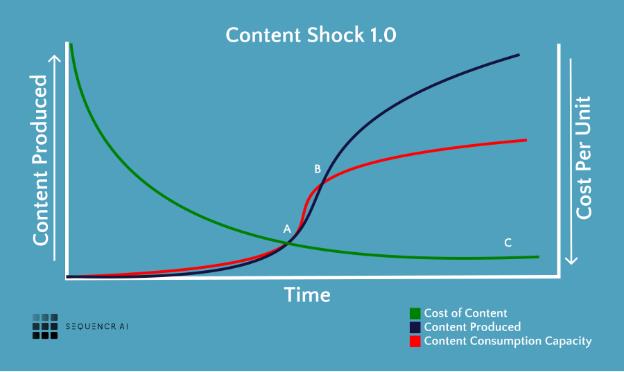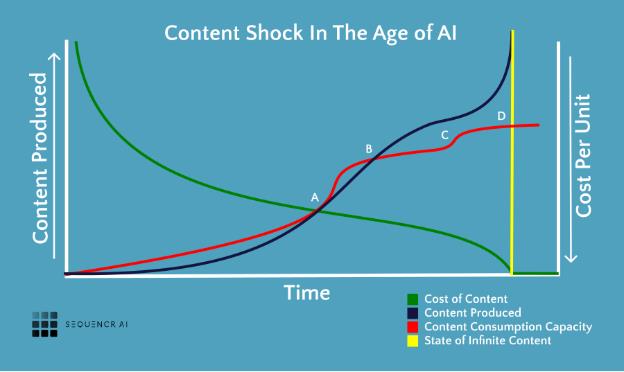
What happens when content becomes limitless? 🤔
Every scroll, search, and swipe now competes with billions of pieces of content generated by humans and machines alike. We're now living in an ecosystem where content is infinite, and attention is the most valuable and most fragile resource.
This article explores the next phase of Content Shock, one where Generative AI has supercharged production but raised the stakes for originality, relevance, and speed. It breaks down how we got here, what it means for marketers and communicators, and what it will take to not just survive but lead in this new era.
If you’re wondering how to create content that cuts through, adapts in real time, and builds meaningful engagement in a world of endless noise, this is your starting point.
In 2014, Mark Schaefer introduced the idea of "Content Shock” and warned of a saturation point where the supply of content outpaces human capacity to consume it.
At its core, Content Shock highlights the imbalance between finite human attention and the ever-expanding universe of digital content. While human demand is capped by physiological and psychological limits, the supply of content continues to grow exponentially, driven by the decreasing cost of production.

Schaefer’s prediction was remarkably prescient. In the decade since his blog post, content creation has truly exploded. In 2014, an estimated 70 million photos and videos were uploaded to Instagram daily. Fast forward to 2024, and that figure has skyrocketed to 1.3 billion uploads a day. Similarly, global data creation has surged from 12.5 zettabytes in 2014 to an estimated 147 zettabytes in 2024 (Statista), representing an extraordinary 1,076% increase.
While the amount of time we spend consuming content has increased over the years, rising from around 7 hours daily in 2014 to 13 hours in 2025, the growth of available content has far outstripped our ability to consume it.
Now, Generative AI is pushing us past a critical threshold. Content Shock is not just about too much content; it’s about Infinite Content, created at near-zero cost and at breakneck speed. What once took weeks or even months of creative development, editing, and production for videos, social campaigns, movie trailers, and branded films can now be generated in minutes. Soon, it will happen in fractions of a second.

The implications for marketing and communications professionals are significant. Infinite Content requires a rethinking of both strategy and execution, from how we capture and hold attention to how we adapt to faster, more volatile content and trend cycles. Moments will rise and fade faster than ever because the line between creation and consumption has collapsed. This is demands a new class of content that is faster, cheaper, and hyper-personalized. In this environment, static content calendars must give way to agile creative workflows, real-time responsiveness, and systems that adapt at the speed of Infinite Content.

While Generative AI is increasing our capacity to consume content, with tools that summarize long-form text, convert articles into podcasts, transform slides into short videos, and synthesize key takeaways on demand, audiences can now process more content in less time.
This expands consumption capacity, but it comes with trade-offs. As speed and efficiency go up, attention spans shrink, depth of engagement declines, and expectations for immediate relevance intensify. We consume more, but engage less deeply, and move on more quickly. For marketers and communicators, this means the window to connect is narrower, and the bar for cut-through is higher than ever.
The question now is how should marketing and communications leaders respond and adapt in the era of Infinite Content.
As we discussed in our article, "Embracing Generative AI for Effective Content Marketing," the rise of Generative AI offers immense opportunities, but it also presents challenges that demand a strategic and creative response.
We would also recommend our companion piece, Thriving in the Era of Infinite Content, which expands on this framework with tactical guidance. Make sure to check it out!
Generative AI, while powerful, is trained on existing content, so it tends to replicate the patterns, norms, and ideas that people are familiar with. This makes it incredibly efficient at producing coherent, on-brand, and grammatically perfect outputs, but it also means it tends to reinforce sameness.
As more marketers rely on generic prompts or default settings, the outputs have become repetitive. Headlines sound the same. Visuals follow the same templates. Tone, cadence, and narrative structure flatten across brands and platforms. In this landscape, sameness becomes a strategic risk.
Here is how to stay ahead:
In a world where speed overtakes substance, creativity becomes the rarest and most valuable currency. Generative AI can flood channels with competent content in seconds, but what it can’t easily replicate is originality, work that surprises, resonates emotionally, or makes someone pause mid-scroll.
When content is infinite, creativity is the antidote to predictability. Audiences are naturally drawn to fresh ideas and unique approaches that capture their attention and spark curiosity.
Creativity won’t just be a differentiator; it will be the cornerstone of long-term relevance and engagement. Brands that embrace bold storytelling, unexpected formats, and innovative concepts will stand out even more in the face of Infinite Content.
But does creativity mean abandoning AI? Not at all. In fact, the opposite is true.
Generative AI accelerates the pace of content and trend cycles. Memes will emerge, peak, and fade before many even realize they existed. In this high-velocity environment, success is about showing up in a distinctive way. The brands that break through will be the ones that engage with both speed and creativity, using human + AI to deliver fresh, relevant ideas.
Audiences expect more than just relevant messaging; they crave personalized experiences that resonate with their unique needs and preferences. To meet this demand, marketers and communicators must harness Generative AI to achieve true hyper-personalization, evolving from broad 1:many campaigns to 1:few and ultimately to authentic 1:1 engagement.
Generative AI can unlock and enable this personalization, adjusting creative assets for different channels and audiences, generating individualized content variations, and automating delivery across touchpoints, from email to web and social.
Personalization creates deeper connections with audiences, cutting through the noise of generic content. Whether it’s a tailored product recommendation, a personalized onboarding video, or content that evolves based on user behavior, this level of precision builds trust, fosters loyalty, and drives meaningful engagement.
While creativity is the foundation of success in the era of infinite content, data is the fuel that powers it. To stay competitive, marketers and communicators must build strong data foundations, collecting, organizing, and activating audience insights in ways that fuel better decisions and better content.
Generative AI thrives on structured, real-time data. From CRM and behavioral analytics to first-party engagement signals, the quality of your inputs directly impacts the quality of your outputs. Robust data strategies enable continuous learning, sharper targeting, and improved effectiveness. AI helps marketers understand what’s working, uncover hidden opportunities, and stay ahead of audience needs before they’re even expressed.
Creative and personalized content is only as effective as a brand’s ability to deliver it at the right moment. As content cycles accelerate, marketing and communications teams must adopt agile workflows, AI-enabled tools, and flexible processes that allow for rapid iteration, real-time feedback, and seamless cross-functional collaboration. Static content calendars and rigid campaign timelines are giving way to modular assets, always-on publishing, and AI co-pilots that support faster creation, testing, and optimization.
Infinite Content is an opportunity to innovate. For marketing and communications leaders, the challenge is not just to keep pace, but to lead with intent. That means combining the scale of Generative AI with the originality of human creativity, grounded in data that reveals what truly resonates.
Success will belong to the teams that move fast, think differently, and design for adaptability. AI is not the end of marketing or communications, it’s the next great unlock.
The era of Infinite Content is here. The question is, how will you show up?